Backlink management is the process of tracking, evaluating, and optimizing the backlinks pointing to your website to maximize their positive impact on its SEO performance.
In our article, we cover:
- why you need to actively manage your backlinks
- what metrics you should track
- practical link-building management tips
- best backlink management tools for the job
Key takeaways
- Backlink management is crucial for SEO success, impacting site authority and search engine rankings.
- When assessing the quality of the backlinks, pay attention to their DA/DR, relevance, and the traffic of the linking site, as well as when they were placed and whether they’re indexed.
- Anchor text diversity is important to avoid search engine penalties for over-optimization.
- Tracking keyword rankings and page conversions are two metrics evaluating the impact of backlinks.
- Monitoring the Spam Score, Moz’s proprietary metric, is another way to assess backlink trustworthiness.
- Regularly checking for and reclaiming lost backlinks helps you save resources that would have been lost, for example, due to link rot.
- There’s no consensus on a good ratio of dofollow to nofollow links. Both types contribute to a healthy link profile.
- Referral traffic from backlinks is a direct indicator of their performance.
- Competitor backlink analysis can uncover new link-building opportunities but aim to surpass, not just match their profiles.
- Tools like Ahrefs, Majestic, Google Disavow Tool, SEranking, Sitechecker, and BacklinkManager are key to effective and efficient backlink management and analysis.
- Need advice on how to manage your backlinks? Get in touch with the Editorial.Link team.
Why Is Backlink Management Important?
Managing backlinks is essential for successful SEO campaigns.
Think about it:
Backlinks are one of the key ranking factors as they indicate the quality of your content.
Backlinks signal to search engines that your content is valuable and trustworthy. This perceived endorsement increases your site’s authority, which is an important SEO ranking factor.
If a solid backlink profile helps you outperform your competitors in SERPs, it’s a no-brainer that you should look after it.
In practice, this means focusing your link-building efforts on high-quality websites that can boost your authority and bring referral traffic as well as avoiding search engine penalties or even deindexing because of spammy links.
It doesn’t stop there.
If you’re outsourcing link-building to an agency, backlink management can save you a lot of money that could be lost on links that decay over time and never get replaced.
🤔 What You Need To Track

When conducting a backlink audit, there are a few factors to consider.
Let’s have a look at 3 of them: backlinks, anchor text, and ranking.
Backlinks
Backlink tracking isn’t just about the number of links pointing to your site because not all links are created equal.
A link from a website with high DR like Forbes has much more impact on your ranking than a link from a social media or forum post.
The quality of the linking site is much more than its DR, though.
For Will Rice, the SEO & Marketing Manager at MeasureMinds, the website’s traffic matters a lot too:
The amount of traffic going to a domain is a great indicator of how powerful a site is. The more traffic, the more people that can potentially click on your link. Also, the more likely that this site is conducting their own SEO well.
Will points out that it’s not only about how much traffic but also its origin:
Getting links from domains that have a high amount of traffic from the countries you operate in is very important. If you operate only in the UK & US, you only want links from domains with high amounts of traffic in these countries.
Moreover, the link needs to be from a relevant site.
A link from a domain in your niche is far more powerful than a link from a domain not in your niche – even if the latter has a higher domain rating. Majestic SEO has an excellent metric for this – ‘Topical trust flow’.
So for Editorial.Link, getting a link from Search Engine Land is great, but from a page selling heavy machinery, not so.
Your partners don’t need to be in the same niche, but should at least have the same target audience. For example, if you’re in the wedding dress business, links from a catering company, a reception venue, or wedding photography websites are all good.
When the link was placed matters a lot.
Generally, the older the link, the better. Moreover, a large concentration of low-quality links appearing within a short period can be an indication of black SEO attacks.
And of course, make sure that the link is indexed by the SEs. Otherwise, it isn’t going to pass any link equity to your site.
Is that all?
No. There are a couple more factors to consider.
Anchor Text
Anchor text is the clickable text of the hyperlink.
On the one hand, you want the anchor texts pointing to your site to be relevant and contain the keywords that you want to rank for.
However, this needs to be done naturally. If the exact keyword is overused in the text too many times, search engines can consider it as an attempt to manipulate rankings, which can lead to penalties.
Have a look at the example of these two excerpts to see what I mean:
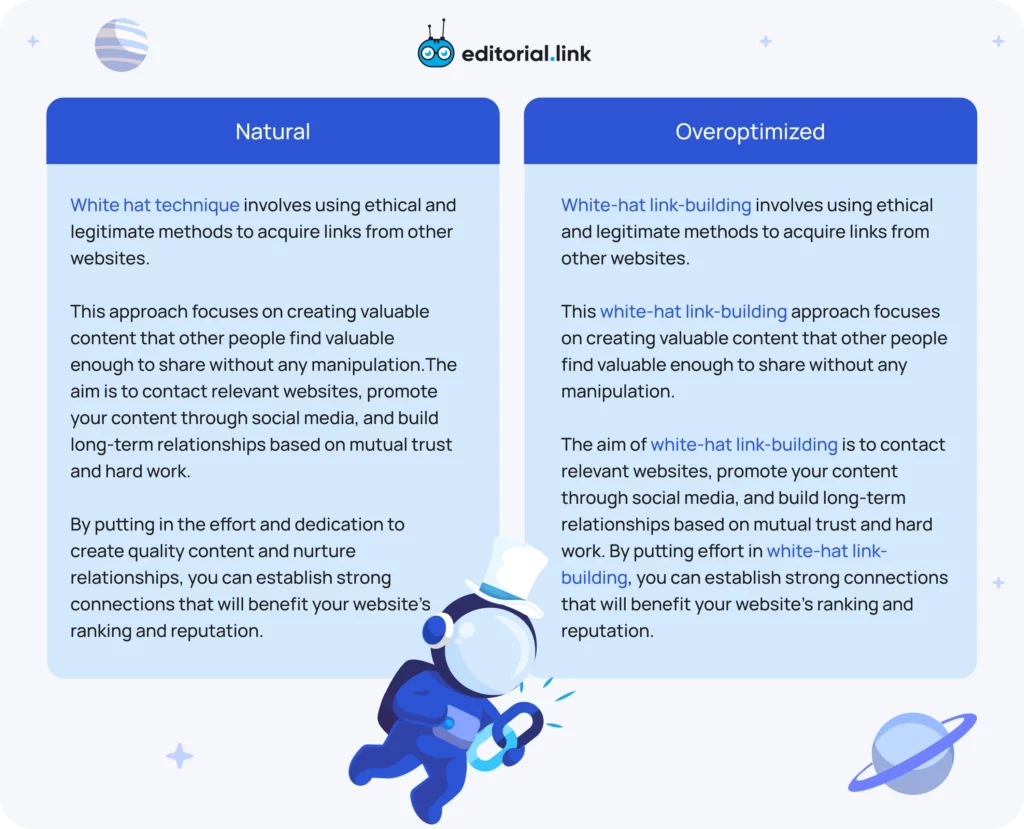
To avoid over-optimizing the text, we recommend not using the same anchor text more than 1-2 times per page.
Ranking
Why do you build backlinks for your pages?
To give them a boost in SERPs! If so, it’s necessary to consistently track the performance of each page to evaluate the impact of the acquired links.
Evelina Milenova, the SEO Manager at OpinionStage, goes one step further. For her, conversions that are the most important success KPI:
The biggest measure of success is conversions. You can track the change in position for the focus keywords and organic traffic. But if you’re not converting traffic, it becomes a vanity metric.
This one is a bit tricky though.
Apart from building links, you’re probably trying to improve the page performance in other ways, for example, by updating and optimizing the content. In this situation, attributing potential improvements to new links may be challenging.
Referral traffic could be used as a potential metric to evaluate the impact of the links.
Overall, keep your eyes on the prize. The goal is to rank higher and convert better, and if you’re achieving this, it doesn’t matter how much exactly the backlinks help.
Bonus tips: Brand mentions & citations
With AI search reshaping how information is surfaced, brand mentions without links matter more than ever.
Large models consider not only backlinks but also patterns of brand citations to assess authority.
Tracking brand mentions is now part of smart backlink management.
They reveal backlink opportunities and shape how often your brand appears in AI-generated results.
🚀 Useful Tips for Effective Backlink Management
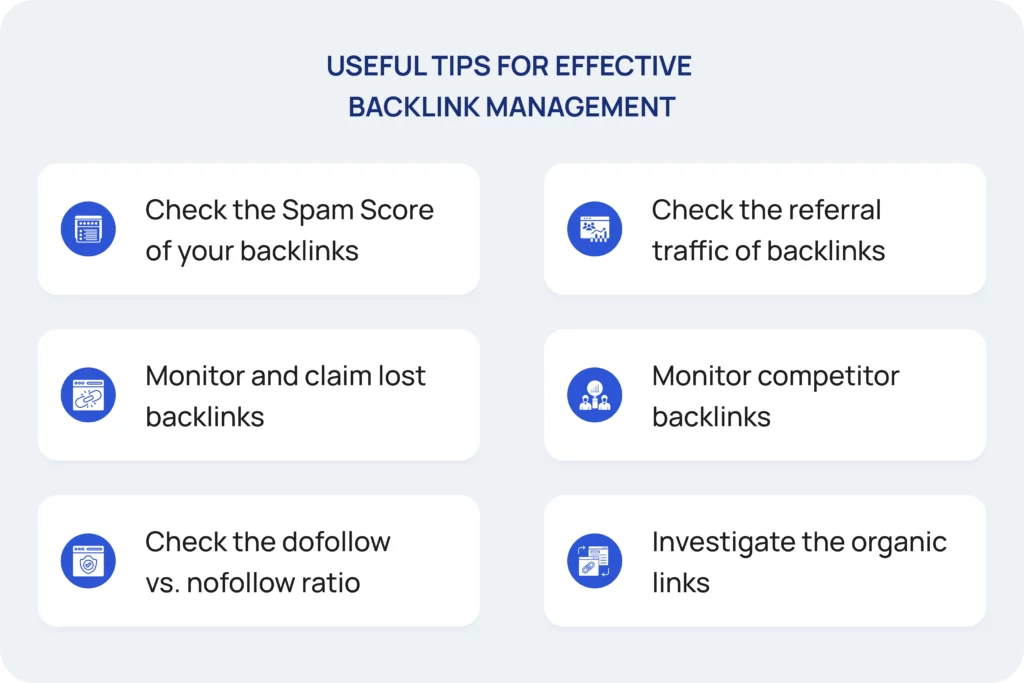
We’ve already covered quite a lot of useful advice but we’re not done yet. Here are a few more tips on how to manage links effectively.
Check the Spam Score of your backlinks
Spam Score is another metric to assess the trustworthiness of a page.
MOZ, who developed the metric, has identified 27 features shared by sites penalized or banned by Google and that’s what they use to calculate the score.
What’s a good Spam Score?
Anything between 1-30% is considered low, 31-60% - medium, and 61-100% - high.
However, a high Spam Score doesn’t mean you should dismiss a website right away.
As the metric uses multiple signals and is based on correlation rather than causation, it’s possible to get a high score, for example, because the site is new and has a low domain authority. It doesn’t mean that they’re doing something dodgy.
Simply use the metric as just one of the factors to consider when evaluating backlinks.

Monitor and claim lost backlinks
According to Ahrefs, 66.5% of links built in the last 9 years have disappeared. That’s around 7% a year, give or take.
How do you feel about losing so many hard-earned links every year?
I think I can guess. That’s why it’s essential to monitor your site for lost links and replace them regularly.
Here’s how you can do it in Ahrefs.
1) In Site Explorer, type in your domain.

2) From the sidebar menu, choose Broken backlinks.
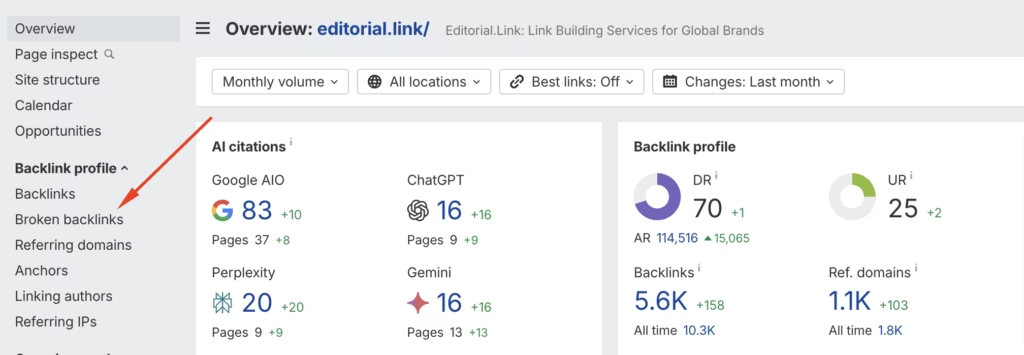
3) Sort the results by Domain Rating, URL Rating (UR), or Traffic to prioritize the sites to contact (for example, I use forbes.com).
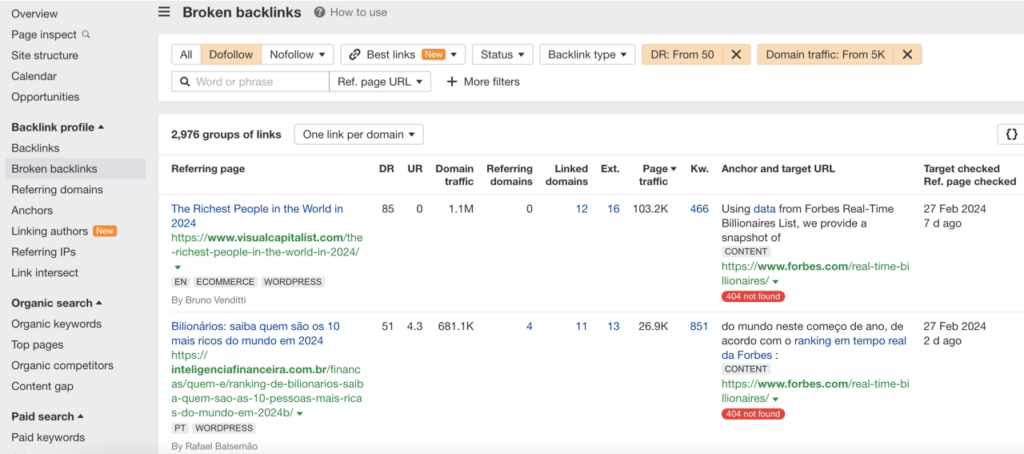
Another option is using a dedicated link monitoring tool like Sitetracker or BacklinkManager, which warns you about disappearing links automatically.
Check the dofollow vs. nofollow ratio
Dofollow backlinks are most valuable from the SEO perspective because they pump the link juice.
It doesn’t mean that nofollow links don’t matter though.
Firstly, in 2019, Google changed how it treats such links. Instead of ignoring them completely, as it used to, it now uses them as signals:
All the link attributes—sponsored, ugc, and nofollow—are treated as hints about which links to consider or exclude within Search. We'll use these hints—along with other signals—as a way to better understand how to appropriately analyze and use links within our systems.
Secondly, a healthy link profile contains both dofollow and nofollow links. A lack of nofollow links pointing to your site may indicate that you're trying to play the system.
What’s a good dofollow to nofollow ratio?
Unfortunately, Google doesn’t provide any definitive answer or recommendation here.
I’ve asked Nick Malekos, the Head of SEO at LearnWorlds and Founder at Marketing Experts Hub, about it, and in his opinion, more than 10% of nofollow links could be a reason to worry:
I don’t pay much attention there, but I would worry if nofollows are >10% and will take action if they are more than >20%.
For Kristavja, a decent ratio is 60:40, but just like Nick, she doesn’t find the ratio that important either:
It’s best to focus more on the quality and relevance of the links rather than achieving a specific ratio. But the general rule of thumb that many marketers adopt is the 60:40 ratio.
Out of curiosity, I’ve had a look at the top 5 pages ranking for the keyword ‘link-building’ and here’s what I found:
- 81.9% dofollow (2.3k backlinks)
- 78.87% dofollow (5.5k backlinks)
- 95.93% dofollow (10.4k backlinks)
- 83.44% dofollow (4.1k backlinks)
- 89.92% dofollow (2k backlinks)
The number of backlinks or their dofollow status doesn’t seem to have much impact on their ranking in this particular case.
Check the referral traffic of backlinks
Apart from increasing the site authority and improving organic search rankings, backlinks drive referral traffic to your website.
And when you think about it, referral traffic is the only metric that shows you directly how your links are performing.
So this is yet another thing to monitor when you're conducting your backlink profile audit.
Here’s how to do it in Google Analytics:
1) Log in to Google Analytics
2) Navigate to Reports in the menu.

3) Click on Acquisition and choose Traffic acquisition.
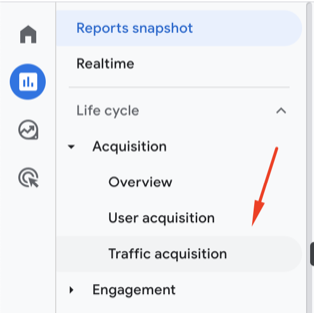
4) Use the filters to obtain the referral data. To do so, choose ‘Session medium’ as a dimension, ‘contains’ as a match type, and ‘referral’ as a dimension value. Click Apply at the bottom.
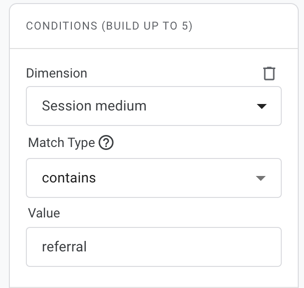
5) This will give you a list of referring domains with all the traffic data. Unfortunately, it’s not possible to track the traffic from a specific page like this.
Monitor Competitor Backlinks
Competitor backlinks analysis is an old trick in the SEO game: you analyze their backlink profiles to find opportunities you haven’t taken advantage of yet.
The idea behind it is logical: if something works for them, it might work for you:
Competitor backlink analysis is a great place to start your link-building efforts. You can see what links helped push your competitors forward and find websites that engage in link exchanges.
There are a couple of caveats here:
First, by matching what your competitors do, you won’t outperform them.
You don’t want to copy your competitor’s backlink profile. You want to surpass it. Rather than reaching out to the same websites – analyze. What’s the niche of the websites linking to this competitor? What pages is this company building links to?
Secondly, securing links on some sites, let’s say directories or listicles, may not be feasible.
The reality is that highly reputable sites won’t feature your product for free, and if you’re in a highly competitive niche like SaaS, it’s difficult to outbid the established competition.
With that in mind, here’s how to identify link-building opportunities in Ahrefs.
1) Enter your domain URL into the Site Explorer and head to the Organic competitors report. That’s how you find your main competitors.
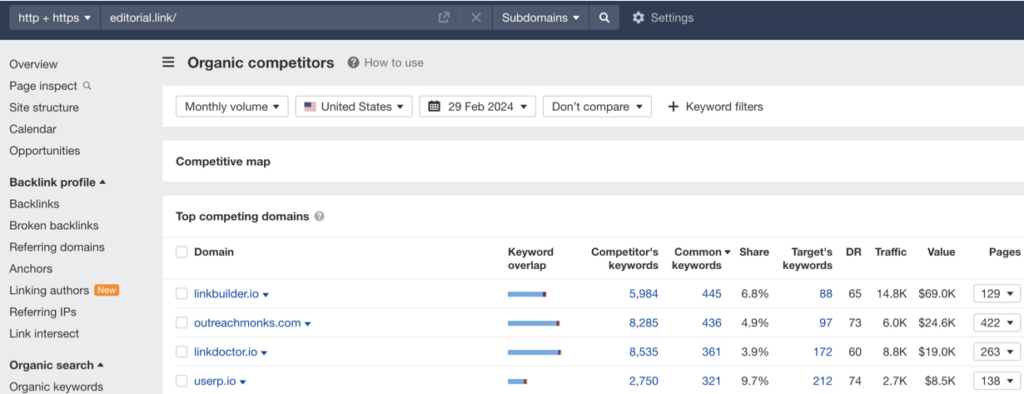
2) Next, analyze each of them by running a Backlinks report on each of them.
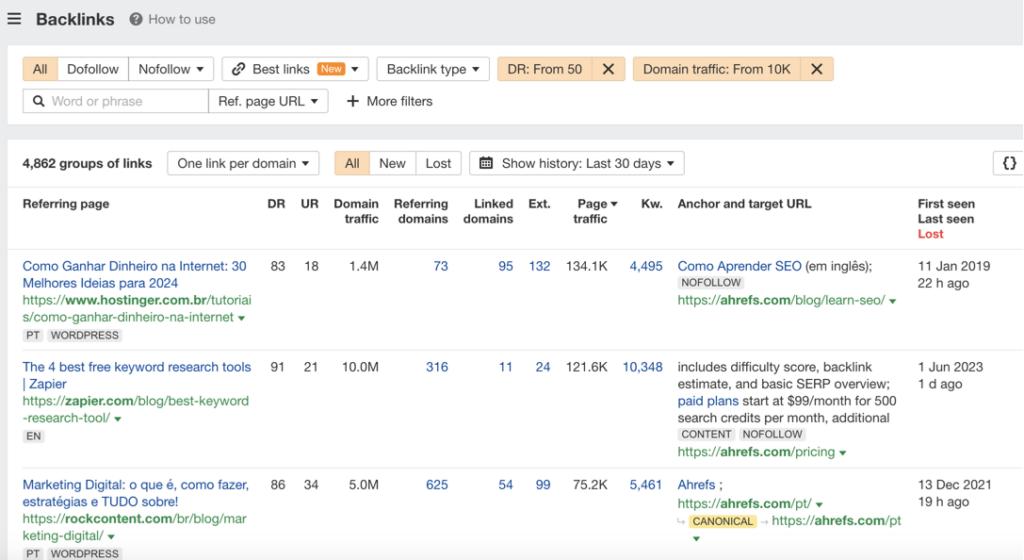
3) Use filters to identify pages with the right DR, traffic, language, etc
Alternatively, you can use the Link Intersect tool to find all the sites linking to your competitors but not yours.
To use it, you head to Site Explorer and choose Link Intersect from the sidebar menu. Next, enter your competitors’ URLs (Show me who is linked to these domains) as well as yours (But doesn’t link to).
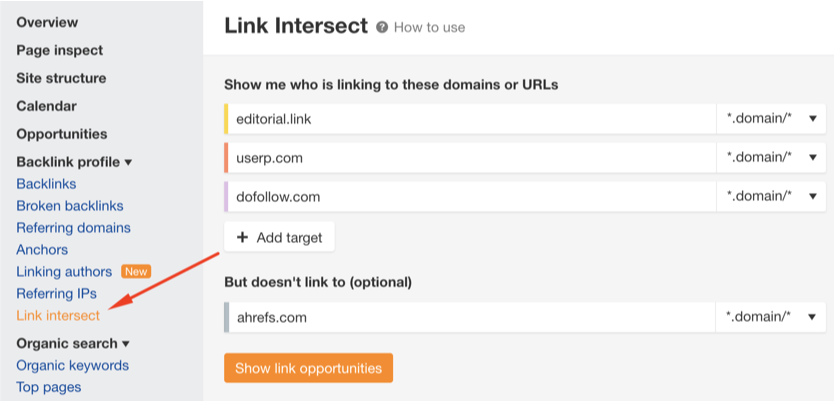
Click on Show link opportunities and here’s the report that you get.
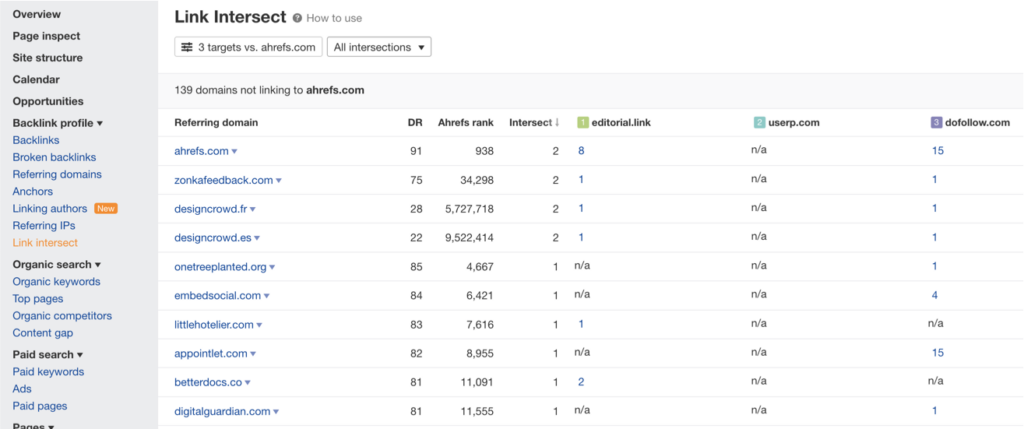
And when you click on the number, you get detailed information about each of the links that will help you identify the right sites to reach out to.
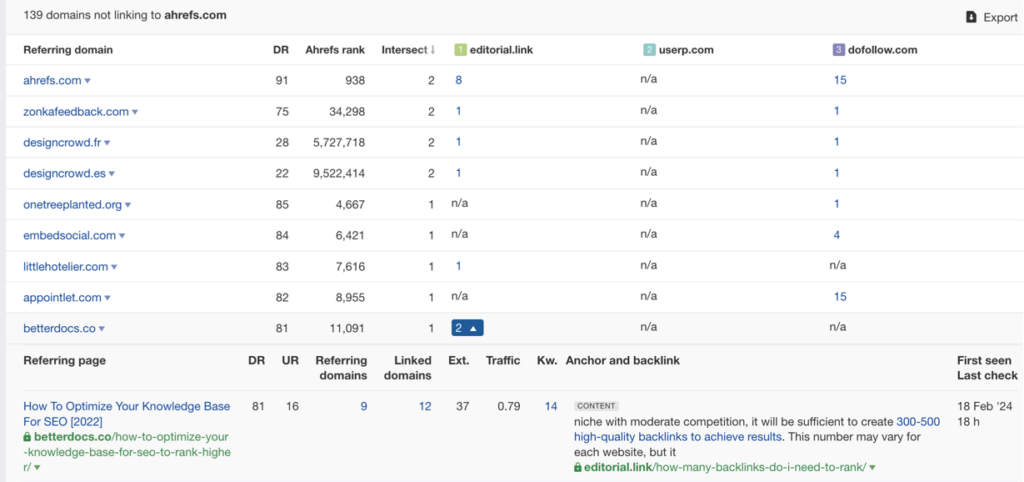
Finally, you can find valuable link opportunities with the Ahrefs Content Explorer.
To do so, run a search for pages containing your competitors’ names: “competitor X” ”competitor Y” “competitors Z”, etc.
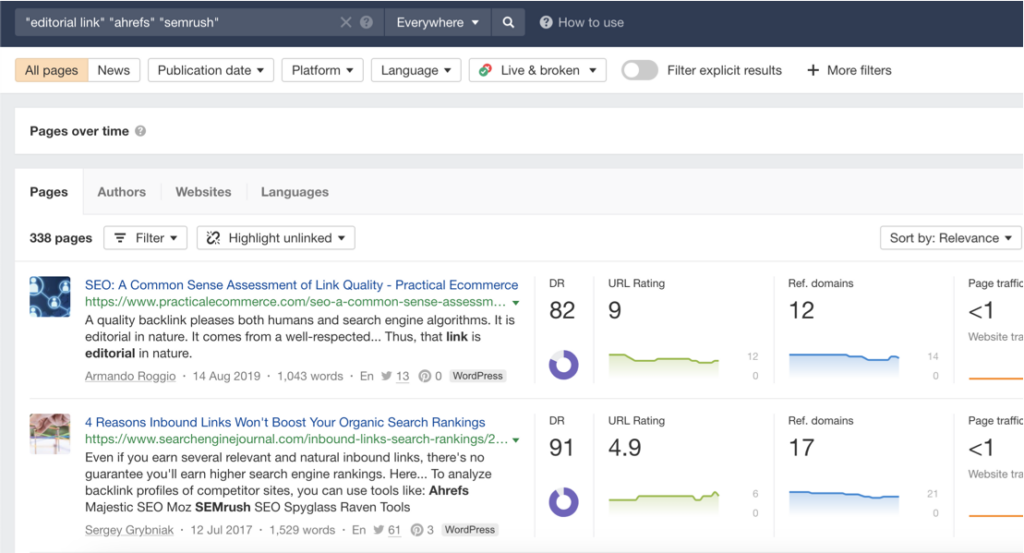
Investigate the organic links
If your content is attracting backlinks organically, it’s worth investigating what makes it attractive to others. With such insights, you can focus your efforts on creating more of such linkable assets.
Try and think of it as an investigative task. You are the SEO Sherlock Holmes following the trail and solving the case…Go through your backlink profile one by one starting with the most powerful. Think about where they came from. Why did they link to you? Can you get another one?
Will recommends going one step further and reaching out to the website owners for feedback:
As an example, I found a link from a very authoritative SEO blog once. I contacted the author on LinkedIn and asked why they linked to me. They found me through a Tweet someone else published via a mutual content-sharing platform. They liked the blog and included it in their roundup. They then said they would publish my content regularly in their roundups and have done so weekly for a few years now!
🤝 Tools for Backlink Management
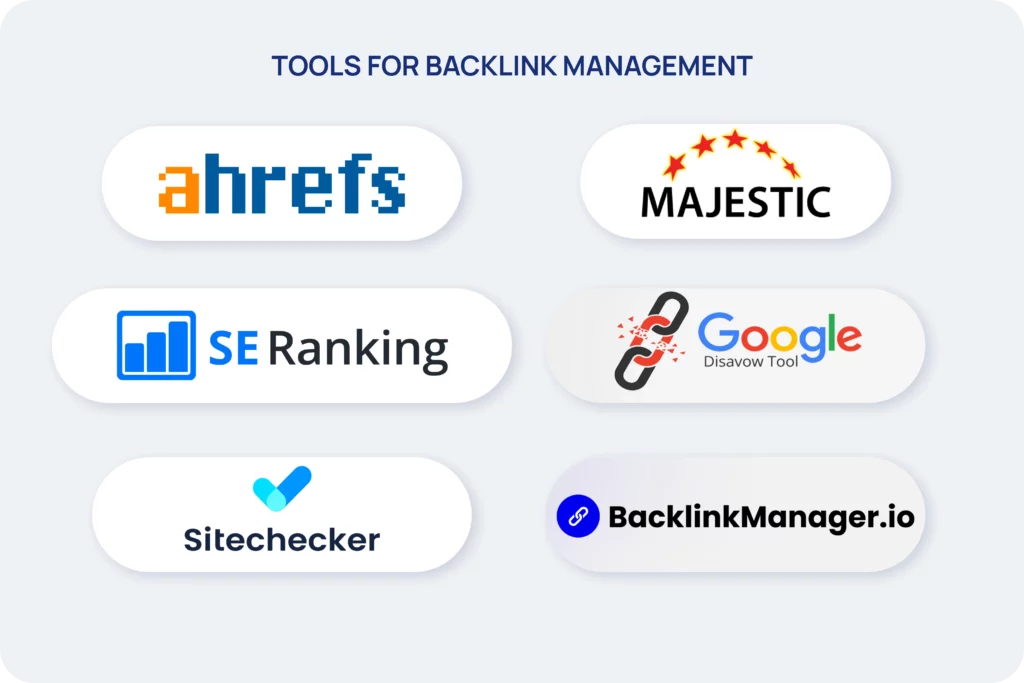
1. Ahrefs
I’ve already made quite a few references to Ahrefs, and indeed the tool requires no introductions.
It’s a go-to all-round SEO platform with powerful capabilities for content teams, marketing agencies, and link-builders looking for opportunities to improve the performance of their websites.
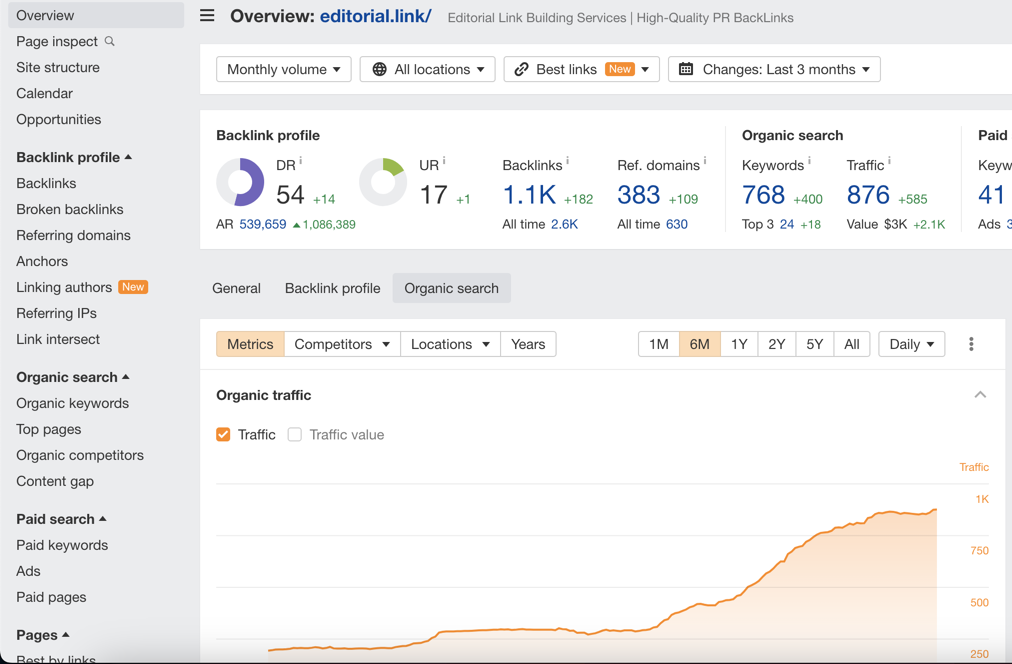
When it comes to backlink management, its key features include:
- A comprehensive backlink database - in our opinion the biggest and most current among tools, which is key to backlink profile analysis;
- Backlinks reports and Link Intersect tool for competitor backlink analysis;
- Lost and new backlinks tracking - to stay on top of changes to your backlink profile;
- Broken links - to identify broken outbound and inbound links, including to your competitors’ sites;
- Content and keyword explorer - to identify trending topics and keywords for your content and increase your chances of creating link-bait assets.
In addition to its functionality, Ahrefs is known for its blog posts featuring brilliant how-to guides, which flatten the learning curve for new users.
When it comes to downsides, the main one is pricing. The lowest plan, Lite, comes at $99/month, and it doesn’t offer you access to some of the key features, like Broken Links.
This may not be affordable to smaller teams or freelancers, especially, early on in their journey.
2. Majestic
Majestic is a specialized SEO tool that focuses primarily on backlink analysis, offering detailed insights into the link-building strategies of websites.
It’s widely used by SEO professionals, marketers, and website owners for backlink management.
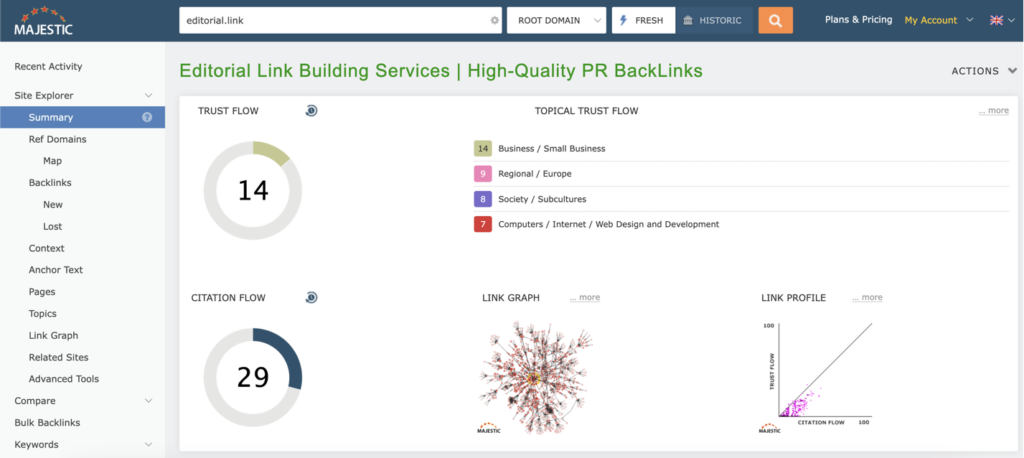
Here's an overview of what Majestic offers:
- Site explorer - providing a comprehensive view of the backlink profile for any given URL, including the number of backlinks, referring domains, and the types of links (dofollow vs. nofollow).
- Trust Flow and Citation Flow - proprietary metrics developed by Majestic, measuring the quality of links pointing to a site (Trust Flow), and their quantity (Citation Flow).
- Bulk Backlink Checker - designed to analyze the backlink profiles of multiple URLs or domains simultaneously.
As a tool designed for link-builders, Majestic features a large backlink database matching its competitors.
What lets it down is its dated UX. Also, it doesn’t offer other SEO tools that you can find in competing products, which may be difficult to sell to marketing teams and agencies.
3. Google Disavow Tool
Google Disavow tool has been built for one purpose only: getting rid of backlinks that could or have harmed your site.

The tool can be useful if your site has been hit by penalties, for example, and you have no other ways to remove spammy, artificial, or low-quality backlinks. This could be the case if the site owner refuses to remove them or you’ve been targeted by a negative SEO attack.
Surprisingly, just 39% of the 518 SEOs we surveyed still rely on the Google Disavow tool.

To do so, you create a text file listing the URLs to disavow and upload it in the Disavow Tool.
4. SEranking
SEranking is an all-in-one SEO tool, positioning itself as an alternative to Ahrefs.
Admittedly, it does offer a wide range of features, including backlink management functionality, that make it an attractive option, especially considering its competitive pricing (although you have to pay extra for some features).

Here’s the overview of SEranking capabilities:
- Domain Trust and Page Trust - proprietary metrics showing how likely a site or page is likely to rank in SERPs;
- Broken backlinks;
- Toxicity score - for identifying links that can harm your rankings;
- Anchor text analysis;
- Extensive database - with 3 trillion backlinks and 262 million domains indexed.
Overall, it may not be as powerful as Ahrefs or Semrush, but it’s a solid solution, especially for those getting into SEO and link-building.
5. Sitechecker
Sitechecker is a versatile platform designed to help website owners, webmasters, and digital marketers improve their website's SEO and overall online visibility.
It provides a comprehensive suite of tools for conducting website audits, monitoring website performance, tracking rankings, and of course, managing backlinks.
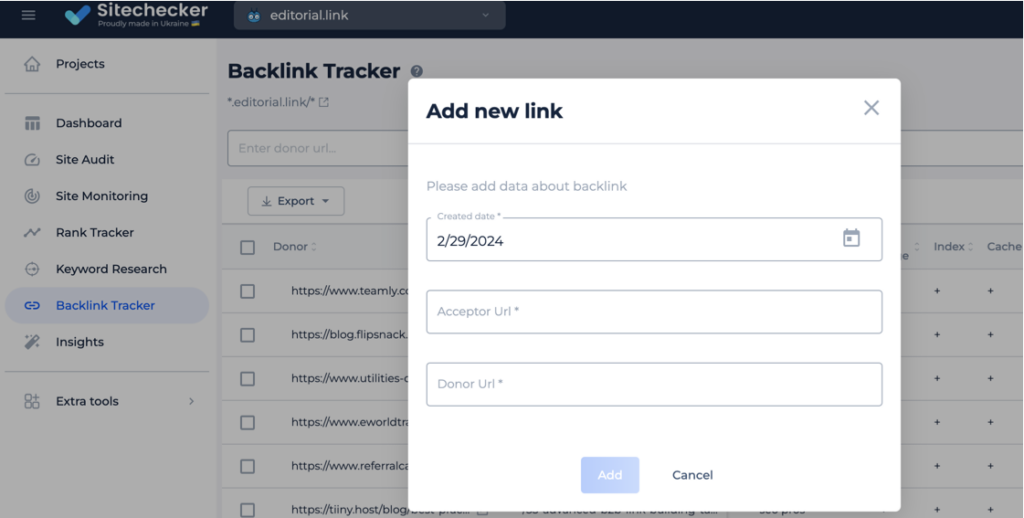
Its Backlink Tracker allows you to monitor all your links from one place. Adding them is easy, you can either import them from your spreadsheet or let the app crawler list them for you.
Once you are there, Sitetracker notifies you whenever a link gets lost or changes status.
6. BacklinkManager
BacklinkManager is a dedicated link-building CRM platform with powerful link-monitoring capabilities.
It’s used by agencies, marketing teams, and freelance link builders to keep track of the links acquired for and by their partners. This was something that was traditionally done in spreadsheets, which, however, have some downsides:
We have been tracking backlinks from link exchanges, guest blogs, and other activities through a big complex Spreadsheet with automated formulas.
Every time we onboard a new partner, we need to create a new spreadsheet, and can’t share it with them.
Spreadsheets can even track live backlinks, but not incredibly accurate, and the process can break.
That’s why Nick’s team has decided to give BacklinkManager a go:
Instead of spending hours to recreate and maintain this process and improve it, we have recently decided to test & migrate our process to Backlinkmanager.io.
We can keep an eye on live backlinks, better track goals per target page, and what we owe/are owed by partners.
Main Backlink Manager features include:
- Link crawler - for 24/7 monitoring of your links. You get notified whenever one of your links goes missing or changes status to no-follow.
- Target groups - for easy organization of your links.
- CRM functionality, like Link Partnership Scorecard, for managing relationships with your clients or link vendors.
- Custom reports.
- Link-matching tool and Link Exchange - to help you identify new link-building opportunities (coming soon).
Final thoughts
Backlink management is an essential part of the link-building process. It allows you to control the quality of the backlinks linking to you and more, importantly, focus your efforts on securing the right kind of links.
Do you need help managing your backlinks and optimizing your backlink profile? Get in touch with the Editorial.Link team!





